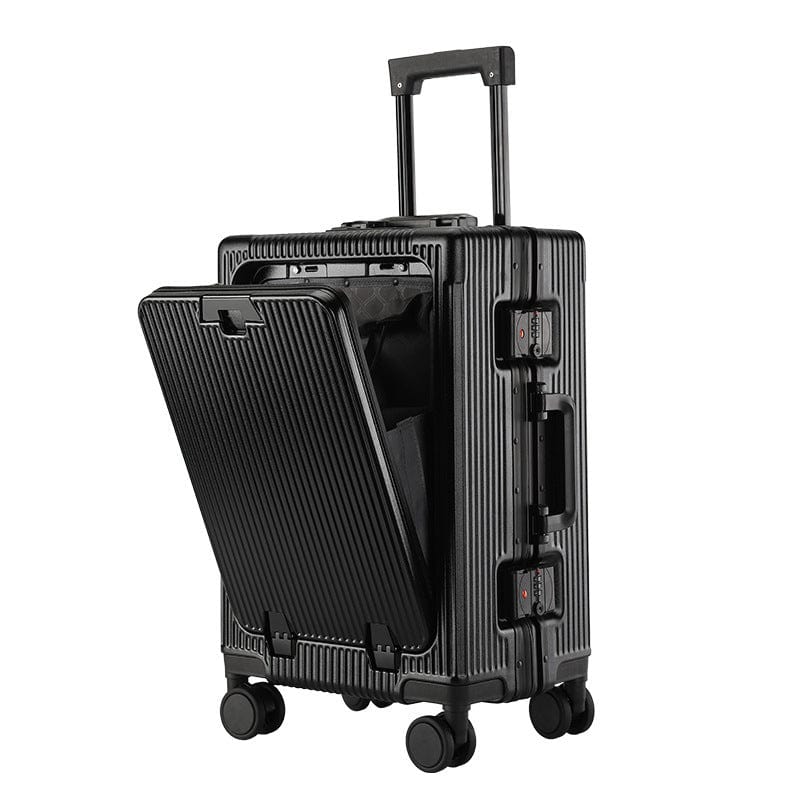Greece draws you in with its timeless charm and endless possibilities. From ancient ruins that echo with legends to sun-soaked beaches and lively villages Greece offers something for every kind of traveler. With over 6,000 islands and the longest coastline in the Mediterranean you’re never far from a new adventure or a hidden gem waiting to be discovered.
Most Popular Travel Backpack for Exploring Greece
Choosing a travel backpack that matches Greece's varied landscapes improves comfort and convenience as you move from ancient ruins in Athens to sunlit beaches or mountainous national parks. Lightweight construction, padded ergonomic straps, and anti-theft zippers help you navigate archeological sites, ferry transfers, and island-hopping with ease. A pack with a 40L–50L capacity provides enough space for summer clothing, swimwear, a rain jacket for occasional showers, and sturdy shoes for hikes at places like Mount Olympus or Vikos Gorge.
Compartments designed for quick access—such as a front pocket for your passport and tickets, a top pocket for sunglasses and sunscreen, and a main section for changes of clothes—streamline travel days. Durable, water-resistant fabric protects your belongings from splashes on boats to the Ionian or Aegean islands. Removable daypacks allow you to pack light for city exploration or excursions to remote beaches in Mykonos or Santorini.
Integrated laptop sleeves support digital nomads enjoying Greek cafés, while side mesh pockets keep a refillable water bottle handy during treks among olive groves or up rocky trails. Backpacks meeting overhead cabin size regulations simplify transit between islands, saving time and baggage fees.
A backpack with these features supports multi-destination adventures across Greece's cities, coastlines, mountains, and islands—keeping essentials organized, secure, and accessible throughout your journey.
Top Historical and Cultural Attractions in Greece
Greece features world-renowned historical sites and vibrant cultural experiences across every region. Step through ancient temples, traverse storied ruins, and discover the living traditions that shape Greek heritage.
Ancient Athens and Its Landmarks
Walk the streets of Athens, home to legendary monuments of classical Greece. Visit the Acropolis, a UNESCO World Heritage Site dating to the 5th century BC, where you’ll encounter the Parthenon, the Erechtheion, and the Temple of Athena Nike. Stand on the Acropolis hilltop for panoramic views over Athens and the Aegean. Wander to the Plaka district, an area where cobblestone streets, neoclassical houses, and open-air cafes bring centuries of history and Athenian culture together. Explore central Athens for additional sites, as ongoing archaeological discoveries emerge with new construction projects.

Exploring Delphi, Olympia, and Mycenae
Discover Greece’s ancient heart through three major archaeological destinations. Delphi, perched on Mount Parnassus, was once considered the center of the world in Greek mythology. Tour the Sanctuary of Apollo, the Temple of Apollo, and the ancient theater, while taking in mountain views and exploring artifacts at the Delphi Archaeological Museum. Travel to Olympia in the Peloponnese, birthplace of the Olympic Games, and visit the Temple of Zeus along with the site’s storied athletic grounds. Head to Mycenae to explore Homeric legends, seeing the Lion Gate and royal tombs of a civilization that influenced Greek epic poetry.

Visiting Byzantine Monasteries and Museums
Experience spiritual and artistic riches in Greece’s Byzantine heritage. Witness the monasteries of Meteora in Thessaly, standing atop towering rock formations—a UNESCO site with origins in the 14th century, these monasteries showcase remarkable frescoes and architecture. Admire relics of the Byzantine era in Thessaloniki’s medieval churches and vibrant museums. Tour the monastic state of Mount Athos on the Chalkidiki peninsula, where ancient traditions continue, though access remains restricted. Throughout your travels, engage with local museums displaying centuries of art, icons, and religious treasures, each providing insight into Greece’s enduring cultural legacy.

Experiencing Greek Island Life
Greece’s islands combine stunning scenery, vibrant villages, crystal-clear waters, and distinct cultures. Island life goes beyond beaches, revealing architectural marvels, regional cuisine, and unique traditions.
Iconic Islands: Santorini, Mykonos, and Crete
Santorini delivers dramatic caldera views, whitewashed cliffside villages like Oia and Fira, volcanic landscapes, and famous sunsets. You’ll find distinctive beaches including Red Beach, Kamari, and Perissa with contrasting sands and turquoise waters.
Mykonos attracts with lively nightlife, world-renowned beach clubs, and pristine shores like Paradise and Psarou. The island’s white labyrinthine streets, iconic windmills, and harborside cafes at Little Venice provide a blend of cosmopolitan flair and traditional Cycladic character.
Crete, the largest island, balances lively towns with wild gorges and mountain villages. Explore the Palace of Knossos, hike the Samaria Gorge, or sample Cretan cuisine in rustic tavernas. Beaches such as Elafonissi and Balos offer soft pink sands and clear lagoons.

Lesser-Known Gems: Naxos, Paros, and Hydra
Naxos, the greenest Cycladic island, provides mountain villages, fertile valleys, and uncrowded beaches. Villages like Halki and Apiranthos showcase marble-paved streets and Byzantine churches. Naxian cuisine features local cheeses, honeys, and potatoes.
Paros offers traditional fishing villages, serene beaches, and whitewashed towns with blue-domed churches. Naoussa charms with its harborfront dining, while the inland Lefkes village boasts narrow alleys and Venetian architecture.
Hydra stands out with its preserved architecture, donkey-filled stone streets, and absence of cars. Island visitors stroll waterfront promenades, explore artist studios, and enjoy pebbled beaches on foot or by water taxi.
Island-Hopping Adventures
Greece’s proximity of islands enables effortless island-hopping using ferries and boats. You might combine Cycladic classics such as Santorini, Mykonos, and Paros, or explore the quieter Small Cyclades for secluded coves and tranquil swims.
Sailing itineraries connect Ionian islands like Corfu and Kefalonia, each with distinctive cuisine and lush interiors. Short crossings between Dodecanese gems, including Rhodes and Symi, introduce medieval towns and wild beaches.
Frequent ferry routes, with up to 120 daily departures in peak season across major island groups, support flexible journeys. Choosing routes by region or interest—romantic getaways, beach escapes, or culinary trails—lets you create a personalized Aegean or Ionian adventure.

Outdoor Activities and Natural Wonders
Greece’s diverse geography creates a playground for nature lovers and adventure seekers. Breathtaking landscapes span from soaring mountains and dramatic gorges to idyllic beaches and turquoise waters.
Hiking Meteora and Samaria Gorge
Hiking in Greece leads you through some of its most spectacular natural settings. Meteora in central Greece offers surreal hiking trails around massive rock pillars topped with centuries-old monasteries. Paths wind past dramatic cliffs, with panoramic views making each step a highlight. Six active monasteries remain accessible, and the oldest date back to the 14th century, blending cultural immersion with outdoor exploration.
In Crete, the Samaria Gorge offers a striking 16 km trek designated as a UNESCO Biosphere Reserve. Traversing rugged terrain, you’ll pass towering limestone cliffs, pine forests, and the famous Iron Gates—a passage just 4 meters wide with 300-meter-high walls. The Samaria Gorge hike ranks among Greece’s most popular outdoor adventures, attracting both avid hikers and casual walkers from April to October.
Enjoying Greece’s Beaches and Coastal Beauty
Exploring Greece’s coastline reveals an extensive selection of beaches, each offering unique charm. Over 13,600 km of coastline and more than 6,000 islands provide endless options for swimmers, snorkelers, and sunbathers.
Elafonissi Beach in southwestern Crete boasts shimmering pink sand formed from crushed shells, set against clear turquoise waters perfect for swimming or snorkeling. On Mykonos, celebrated beaches like Psarou and Super Paradise attract visitors seeking both relaxation and watersports.
The Cycladic islands—Santorini, Naxos, and Paros—feature postcard-worthy white-washed villages that descend toward azure bays. Relax on the volcanic black sands of Kamari or Perissa in Santorini, or discover secluded coves and golden beaches in less-visited spots like Milos and Serifos.
On the mainland, the Halkidiki Peninsula and Athens Riviera present wide sandy stretches, gentle coves, and crystalline waters close to vibrant cities. These regions offer easy access to coastal hikes and water activities, making them popular choices for outdoor enthusiasts searching for Greece’s natural wonders.
Savoring Greek Cuisine and Local Traditions
Greece offers a rich culinary scene shaped by thousands of years of tradition. Local ingredients, regional specialties, and social customs combine to deliver a distinct food experience found in family-run tavernas, bustling city markets, and scenic island eateries.
Must-Try Greek Dishes and Food Experiences
Sampling staple Greek dishes forms a core part of discovering the country’s culture. Menus in most tavernas include classics like feta-topped Greek salads, creamy mezze spreads such as hummus and tzatziki, and mains including moussaka, grilled kebabs, and freshly caught fish. In coastal towns, seafood like calamari and octopus comes grilled or fried, especially during summer months. Sweet treats abound with honey-drenched baklava and fluffy loukoumades. For breakfast, locals enjoy a Greek coffee with a slice of bougatsa—a flaky pastry filled with cheese or custard.
Regional variations exist across Greece. Italian-influenced pasta dishes appear often in the Ionian Islands—examples are seafood linguine and pastitsada. Dolmades, or grape leaves stuffed with rice and herbs, feature widely in the Aegean area. Rustic villages serve slow-cooked roasts, village cheeses, and seasonal tomato salads enhanced by fresh-pressed olive oil. Local markets present the chance to taste in-season fruits, olives, and cheeses, immersing you in the everyday flavors of Greece.
Wine Tasting and Culinary Tours
Exploring Greek wine regions reveals the country’s ancient viticulture and modern winemaking revival. The Peloponnese, Santorini, and Northern Greece house renowned vineyards where you can sample varietals like Agiorgitiko, Assyrtiko, and Moschofilero. Many wineries offer guided tastings paired with artisanal cheeses and local bread. Santorini, in particular, stands out for its crisp Assyrtiko white—often cultivated from centuries-old vines grown in volcanic soil.
Culinary tours in Athens and Thessaloniki let you experience traditional food markets, bakeries, and small eateries guided by local experts. Food walks introduce you to specialties such as spanakopita, grilled souvlaki, and region-specific pies. Farm visits and cooking classes run throughout Greece, allowing hands-on immersion in everything from pressing olive oil to perfecting phyllo dough. These experiences connect you directly to local producers, giving insight into generational recipes and community traditions.
|
Greek Culinary Highlights |
Example Dishes/Experiences
|
|---|---|
|
Taverna Main Courses |
Moussaka, grilled fish, kebabs |
|
Mezze and Appetizers |
Tzatziki, hummus, dolmades |
|
Regional Specialties |
Bougatsa (Crete), pastitsada (Corfu), baklava |
|
Wine Varietals |
Assyrtiko (Santorini), Agiorgitiko (Nemea) |
|
Culinary Tours & Tastings |
Athens food walks, vineyard tastings, classes |
Greek cuisine and traditions infuse every meal and gathering, offering you a direct taste of the country’s heritage as you travel.
Traveling Around Greece: Tips and Insights
Navigating Greece unlocks both ancient cities and secluded beaches, making route planning part of the adventure. Understanding travel timing and transportation options transforms every itinerary, letting you experience the country’s rich history, scenic coastlines, and authentic culture more fully.
Best Times to Visit and Essential Travel Tips
Seasonal timing shapes the Greek travel experience. Peak months from June to August bring warm weather, busy resorts, and lively beaches across mainland and islands. For a calmer atmosphere, April–May and September offer wildflowers, fewer crowds, and lower prices, with sea temperatures still inviting for swimming. Most major events, like festivals in Athens or on the islands, take place in summer, so align your plans with any specific interests.
Safety remains high across Greece, especially in popular areas like Athens, Thessaloniki, or island villages. Standard precautions suffice—keep belongings close in crowded areas and use official taxis or rideshares after dark. Tapping into the local social scene helps solo travelers connect, with many cafés and squares welcoming conversation and new friendships. Most locals speak basic English, especially in tourist zones, and signage in airports, metro stations, and ferry ports appears in both Greek and English for easy navigation.
Getting Around: Ferries, Cars, and Public Transport
Urban centers and remote ruins demand different travel strategies. Ferries dominate inter-island travel, with more than 227 inhabited islands connected through daily crossings, especially in the Cyclades, Dodecanese, and Ionian groups. Standard ferries suit budget travel, while hydrofoils or catamarans halve transit times on main routes, such as Piraeus to Santorini or Mykonos.
On the mainland, KTEL buses reliably link major cities and archaeological sites—examples include Athens to Delphi and Thessaloniki to Halkidiki—with routes operated by regional cooperatives. An efficient, though limited, train network connects Athens with northern cities and some Peloponnese towns. Renting a car increases access to off-the-beaten-path villages, remote monasteries in Meteora, or scenic drives along the Mani Peninsula. Greek roads include modern highways and winding village lanes; stick to highways for long distances and consider smaller vehicles for island driving due to narrow streets.
Travelers frequently combine ferry passages with car rentals on larger islands such as Crete or Rhodes. In Athens, the metro works well for sightseeing due to extensive service around landmarks and neighborhoods. For multi-stop itineraries, organize tickets in advance during high season and factor in ferry departure points, as some islands only connect directly from specific mainlands.
|
Transport Type |
Coverage |
Notable Routes (Examples) |
Best For |
Frequency/Tips
|
|---|---|---|---|---|
|
Ferry/Catamaran |
Over 227 islands |
Piraeus–Santorini, Naxos–Paros |
Island hopping, scenic travel |
Daily service in high season, book ahead |
|
KTEL Bus |
Mainland/intercity |
Athens–Delphi, Thessaloniki–Halkidiki |
Historical sites, budget travel |
Reliable, regional variations |
|
Metro/Train |
Athens, north cities |
Athens–Larisa, Athens Airport |
Urban, city to city |
Metro runs 5 am–midnight in Athens |
|
Car Rental |
Mainland, islands |
Crete, Peloponnese, Mani |
Rural villages, flexibility |
Reserve in advance on popular islands |
Coordinating ferries, buses, and private transport lets you tailor your journey, maximizing Greece’s diverse landscapes and historic wonders.
Conclusion
Greece invites you to discover a world where ancient history meets breathtaking natural beauty and vibrant local culture. No matter your travel style you'll find endless possibilities waiting across its cities islands and countryside.
With a bit of planning and an adventurous spirit you can create a journey that's uniquely yours. Let Greece's legendary charm inspire unforgettable memories and experiences that will stay with you long after your trip ends.
Frequently Asked Questions
Why is Greece a popular travel destination?
Greece is famous for its rich history, stunning natural landscapes, beautiful islands, and vibrant local culture. Visitors enjoy ancient ruins, delicious cuisine, sunny beaches, and lively cities, making it a top choice for travelers seeking diverse experiences.
What are the must-see historical sites in Greece?
Top historical sites include the Acropolis and Parthenon in Athens, ancient Delphi, Olympia, Mycenae, and the monasteries of Meteora. These landmarks offer a glimpse into Greece’s incredible past, mythology, and cultural heritage.
Which Greek islands should I visit?
Popular islands to visit are Santorini for beautiful views and sunsets, Mykonos for nightlife and beaches, and Crete for its size and variety. Lesser-known options like Naxos, Paros, and Hydra offer more authentic local experiences.
What is the best time to visit Greece?
The best months to visit are April-May and September, when the weather is pleasant and crowds are smaller. June to August is peak season, but expect higher prices and busier attractions during this time.
How do I travel between Greek islands?
Greek islands are well-connected by ferries, making island-hopping easy. Several companies operate regular routes, and tickets can often be booked in advance online or at local ports.
What should I look for in a travel backpack for Greece?
Choose a lightweight, 40L-50L backpack with padded straps, anti-theft features, and practical compartments. Water-resistant fabric and a removable daypack are also helpful for comfort and convenience during varied adventures.
What outdoor activities can I enjoy in Greece?
Greece offers hiking in areas like Meteora and Samaria Gorge, water sports along its coastline, and scenic walks on islands. Other options include cycling, sailing, and exploring national parks and mountainous regions.
Is Greece safe for tourists?
Greece is generally very safe and locals are welcoming. Standard travel precautions apply—watch your belongings in busy places, and follow local advice for a worry-free trip.
What currency is used in Greece?
Greece uses the euro (€) as its official currency. Credit cards are widely accepted in most hotels, restaurants, and larger shops, but it’s handy to carry some cash for small purchases.
What are traditional Greek foods to try?
Must-try dishes include moussaka, souvlaki, grilled seafood, bougatsa (pastry), and pastitsada (meat stew). Greek cuisine also features fresh salads, local cheeses, and delicious desserts like baklava and loukoumades.
How do I get around Greece’s mainland and islands?
Travelers can use ferries for island trips, KTEL buses for mainland routes, and the Athens metro for city travel. Renting a car or scooter is also popular for flexibility, especially in less urban or remote areas.













